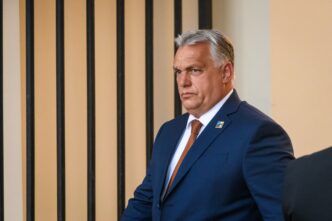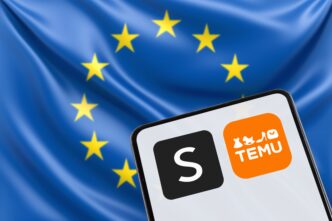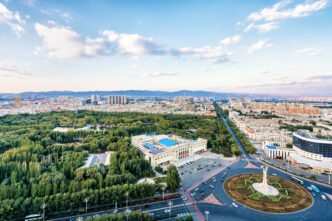Executive Summary
The Story So Far
Why This Matters
Who Thinks What?
A marathon 12-and-a-half-hour European Council summit in Brussels concluded with a complex mix of limited breakthroughs and significant deferrals on key policy fronts, including the critical issue of utilizing frozen Russian assets for Ukraine. While leaders endorsed a new defense roadmap and approved the latest package of sanctions against Russia, deep divisions persisted on migration, specific climate targets, and the mechanism for financing Ukraine’s reconstruction.
EU Support for Ukraine
Sanctions and Frozen Assets
The summit saw a swift agreement on the latest package of sanctions against Russia, following Slovak Prime Minister Robert Fico’s decision to lift his veto. Fico’s concession came after he claimed to achieve support for Slovakia’s automotive industry, finding an unexpected ally in German Chancellor Friedrich Merz.
However, efforts to finalize a plan for using frozen Russian assets to fund a €140 billion loan for Ukraine faced a deadlock. Belgian Prime Minister Bart De Wever maintained his opposition, citing fears that taking the assets, primarily held in a Brussels-based financial depository, could trigger legal action from Moscow.
Leaders ultimately tasked the European Commission to present further options, effectively postponing a decision until at least the next summit in December. Ukrainian President Volodymyr Zelenskyy, who attended the summit, expressed optimism for a breakthrough, emphasizing that Russia must pay for the war it brought to Ukrainian land.
Commission President Ursula von der Leyen tactfully noted that high-level talks “allowed us to identify points we need to clarify,” while European Council President António Costa added that “technical and legal aspects of Europe’s support need to be worked upon.” De Wever, after being ranked among those likely to disrupt the summit, rejected the “bad boy” label, asserting Belgium’s strong stance on immobilized assets.
Defense Readiness and Aid
On defense, EU leaders endorsed the Defense Readiness Roadmap 2030, a strategic plan aimed at preparing member countries for potential conflict by 2030. The roadmap seeks to address capability gaps in crucial areas such as air and missile defense, artillery systems, and military mobility, with Ukraine envisioned as a “steel porcupine” to deter Russian aggression.
As leaders deliberated, a Russian fighter jet and refueling aircraft briefly crossed into Lithuanian airspace, underscoring the urgency of enhanced EU defense. President Zelenskyy also pressed for further military aid, including long-range missiles from the U.S., which Donald Trump has so far ruled out selling to Kyiv, and increased weapon supplies from Germany.
A German official confirmed that Chancellor Merz and Zelenskyy discussed “specific requests” for enhancing Ukraine’s defense capabilities, with Berlin reviewing proposals to protect Ukrainian energy and water infrastructure. Ukraine indicated a preference for purchasing weapons from European industry when using funds from the proposed reparation loan, though it also reserved the right to procure from the U.S. when necessary.
Spain’s leader, Pedro Sánchez, similarly highlighted the need for U.S.-manufactured defense components, such as Patriots and Tomahawks, which he noted are currently only produced in the United States and are crucial for Ukraine’s defense. Spain committed to contributing cash to a NATO-organized fund for purchasing U.S. weapons.
Internal EU Policy Debates
Trade Negotiations
German Chancellor Friedrich Merz unexpectedly announced that leaders had backed the controversial Mercosur trade agreement with Latin American countries, stating, “All 27 countries voted unanimously in favor.” This remark sparked confusion among delegations, as the European Council does not typically vote on trade agreements.
An EU diplomat clarified that European Council President António Costa had sought confirmation from leaders on their willingness to take a stance on the deal by the end of the year, rather than conducting a formal vote at the summit.
Climate and Green Transition
Discussions on climate targets proceeded surprisingly smoothly, with leaders agreeing to a vaguely worded commitment to a green transition without committing to a 2040 goal, which proposes cutting emissions by 90 percent compared to 1990 levels. Polish Prime Minister Donald Tusk welcomed the outcome, calling it a “turning point” and noting the insertion of a “revision clause” into the EU’s carbon-trading system plan for heating and transport emissions.
The 2035 de facto combustion engine ban, a pillar of the EU’s green transition, was expected to be a contentious point but barely registered. Slovakia and the Czech Republic voiced opposition, yet the summit’s official conclusions welcomed the Commission’s proposed ban without mention of watering it down. Ministers are set to reconvene and vote on the 2040 goal on November 4.
Migration Challenges
Despite promising to make migration a “priority,” EU leaders failed to achieve any breakthrough on a stalled proposal for burden-sharing. The bloc recently missed a deadline to agree on a new mechanism for assessing member states’ stress from migrant arrivals and distributing responsibility more equitably.
Italy’s Giorgia Meloni, Denmark’s Mette Frederiksen, and the Netherlands’ Dick Schoof continued their informal “migration breakfasts,” meeting with von der Leyen to discuss accelerating migrant returns. The trio agreed to hold an informal summit next month in Rome to further discuss tougher border and asylum policies.
Digital Policy and Competitiveness
Leaders endorsed a “possible” minimum age for children to use social media but did not commit to a bloc-wide ban. Capitals remained divided on whether to set the age at 15 or 16, as well as on the issue of parental consent.
Concerns over China’s export controls on rare earths were raised during discussions on competitiveness. While the EU’s Anti-Coercion Instrument was mentioned as a potential tool, it did not garner significant interest among the leaders.
Addressing the Housing Crisis
For the first time, the continent’s housing crisis made it onto the agenda, with leaders dedicating a substantial 40 minutes to the topic at President Costa’s behest. Greek Prime Minister Kyriakos Mitsotakis called for the Commission to create a database tracking effective housing policies across Europe.
Most leaders acknowledged that while housing remains a national competence, the EU still has a role to play. Commission President von der Leyen announced that the EU executive “is ready to help,” with a European Affordable Housing Plan in the pipeline and the first EU Housing Summit scheduled for 2026.
Looking Ahead
The extensive summit underscored the persistent challenges in forging consensus among the 27 member states on complex issues, particularly those with significant national implications. While some immediate agreements were reached, many critical decisions were postponed, signaling ongoing internal negotiations and potential for further debate in the coming months. The EU continues to grapple with balancing national interests against the need for unified action on both internal policies and external pressures.








